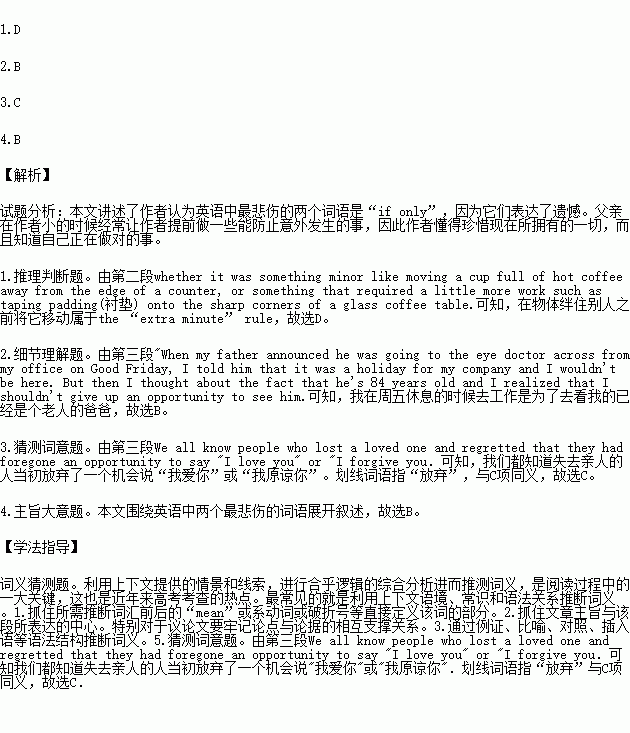题目内容
Two of the saddest words in the English language are “if only”. I live my life with the goal of never having to say those words, because they convey regret, lost opportunities, mistakes, and disappointment.
My father is famous in our family for saying, “Take the extra minute to do it right.” I always try to live by the “extra minute” rule. When my children were young and likely to cause accidents, I always thought about what I could do to avoid an “if only” moment, whether it was something minor like moving a cup full of hot coffee away from the edge of a counter, or something that required a little more work such as taping padding (衬垫) onto the sharp corners of a glass coffee table.
I don’t only avoid those “if only” moments when it comes to safety. It’s equally important to avoid “if only” in our personal relationships. We all know people who lost a loved one and regretted that they had foregone an opportunity to say “I love you” or “I forgive you.” When my father announced he was going to the eye doctor across from my office on Good Friday, I told him that it was a holiday for my company and I wouldn’t be here. But then I thought about the fact that he’s 84 years old and I realized that I shouldn’t give up an opportunity to see him. I called him and told him I had decided to go to work on my day off after all.
I know there will still be occasions when I have to say “if only” about something, but my life is definitely better because of my policy of doing everything possible to avoid that eventuality. And even though it takes an extra minute to do something right, or it occasionally takes an hour or two in my busy schedule to make a personal connection, I know that I’m doing the right thing. I’m buying myself peace of mind and that’s the best kind of insurance for my emotional well-being.
1.Which of the following is an example of the “extra minute” rule?
A. Start the car the moment everyone is seated.
B. Leave the room for a minute with the iron working.
C. Wait for an extra minute so that the steak tastes better.
D. Move an object out of the way before it trips someone.
2.The author decided to go to her office on Good Friday to ________.
A. keep her appointment with the eye doctor
B. meet her father who was already an old man
C. join in the holiday celebration of the company
D. finish her work before the deadline approached
3.The underlined word “foregone” in Paragraph 3 is closest in meaning to ________.
A. avoidedB. lackedC. abandonedD. took
4.What is the best title for the passage?
A. The Emotional Well-being
B. The Two Saddest Words
C. The Most Useful Rule
D. The Peace of Mind
On Friday, May 16, our class will take a field trip to North Park Zoo. The zoo has lions, elephants, and other interesting animals. Many of the animals we have been studying will be there for us to closely examine.
Our class will be divided into six teams. Each team will have five students and one leader. The leaders are listed in the table.
Team 1 | Miss Banker |
Team 2 | Mrs. Lopez |
Team 3 | Mr. Harper |
Team 4 | Miss Abel |
Team 5 | Mr. Soto |
Team 6 | Mrs. Thomas |
What You Need to Know
The cost is $1.00 for students to enter the zoo. We will leave the school at 9:00 a.m. and return at 2:30 p.m.
On the morning of the trip, the students will be divided into teams. One student from each team will receive a camera. The cameraman will take pictures of the team, the animals, and other fun sights at the zoo.
All members should wear blue shirts. Be sure to war comfortable shoes because we will be walking all day. Please bring a bag lunch and a drink. We will have a picnic at the park inside the zoo. Bring a healthy snack, such as a piece of fruit and a drink, for later in the day.
When we are at the zoo, always remain with your team. Do not leave the team without asking permission from the team leader.
Feeding the Animals
The ONLY animals that students are allowed to feed are those in the children’s Zoo. Special food can be bought at the zoo for 25 cents and given to these animals. Do not feed your lunch to them. It is not food for the animals.
1.Any student taking part in this field trip should ________.
A. spend at least $1.00
B. carry a camera
C. draw pictures of the animals
D. arrive at the zoo at 9:00 a.m.
2.In the Children’s Zoo, students can ________.
A. move freely
B. feed the animals
C. enjoy their lunch
D. get special food for free
3.What type of writing is this text?
A. A news report.
B. An announcement.
C. An introduction to a zoo.
D. A photo competition guide.

